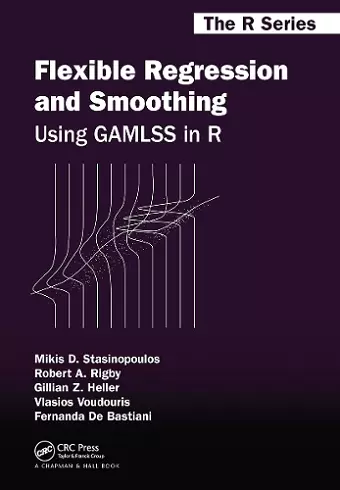Flexible Regression and Smoothing
Using GAMLSS in R
Robert A Rigby author Mikis D Stasinopoulos author Gillian Z Heller author Fernanda De Bastiani author Vlasios Voudouris author
Format:Paperback
Publisher:Taylor & Francis Ltd
Published:30th Sep '20
Currently unavailable, and unfortunately no date known when it will be back
This paperback is available in another edition too:
- Hardback£105.00(9781138197909)

This book is about learning from data using the Generalized Additive Models for Location, Scale and Shape (GAMLSS). GAMLSS extends the Generalized Linear Models (GLMs) and Generalized Additive Models (GAMs) to accommodate large complex datasets, which are increasingly prevalent.
In particular, the GAMLSS statistical framework enables flexible regression and smoothing models to be fitted to the data. The GAMLSS model assumes that the response variable has any parametric (continuous, discrete or mixed) distribution which might be heavy- or light-tailed, and positively or negatively skewed. In addition, all the parameters of the distribution (location, scale, shape) can be modelled as linear or smooth functions of explanatory variables.
Key Features:
- Provides a broad overview of flexible regression and smoothing techniques to learn from data whilst also focusing on the practical application of methodology using GAMLSS software in R.
- Includes a comprehensive collection of real data examples, which reflect the range of problems addressed by GAMLSS models and provide a practical illustration of the process of using flexible GAMLSS models for statistical learning.
- R code integrated into the text for ease of understanding and replication.
- Supplemented by a website with code, data and extra materials.
This book aims to help readers understand how to learn from data encountered in many fields. It will be useful for practitioners and researchers who wish to understand and use the GAMLSS models to learn from data and also for students who wish to learn GAMLSS through practical examples.
"That the authors succeed in communicating the process of learning from data using the GAMLSS suite of tool is due to the clear and effective organization of the book. The book is a complete introduction to GAMLSS models (and by extension GLMs and GAMs) as well as some newer techniques such as semi-parametric neural networks/deep learning and trees. I highly recommend it to any reader interested in advanced machine learning techniques."
—Carlo Di Maio, European Central Bank
"’Flexible Regression and Smoothing: Using GAMLSS in R’ is a comprehensive and authoritative text from the co-authors of perhaps the most flexible regression modeling framework in statistics and supervised machine learning. Traditional regression approaches focus on the mean of the distribution conditional on a set of predictor variables. GAMLSS extends this up to four distribution parameters which are modeled as additive functions of predictor variables. Through this extension, the analyst has a choice of over 90 continuous, discrete and mixed distributions for the response variable which allows modeling of highly skewed and kurtotic distributions while improving transparency and interpretability for the effects of predictor variables driving the model. This well-written book details the methodology and R packages underlying the framework including algorithms, model fitting, additive terms, model diagnostics and examples with real data. The impact of GAMLSS has been demonstrated in many industries including medicine, environmental science, biology, finance and insurance. Data scientists, quantitative analysts and researchers will be enlightened when discovering the myriad of modeling opportunities through the material in this landmark text."
—Edward Tong, PhD
"Generalized additive models for location, scale, and shape (GAMLSS) as introduced by Bob Rigby and Mikis Stasinopoulos in their seminal 2005 paper are one versatile, yet simple me
ISBN: 9780367658069
Dimensions: unknown
Weight: 1100g
572 pages